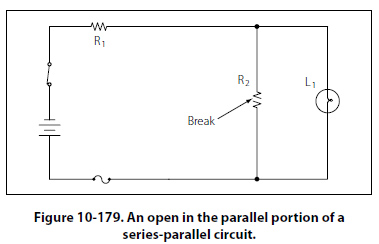Troubleshooting the Shorting Faults in
Parallel Circuit
As in a series circuit, a short in a parallel circuit will
usually cause an open circuit by blowing the fuse.
But, unlike a series circuit, one shorted component in
a parallel circuit will stop current flow by causing the
fuse to open. Refer to the circuit in Figure 10-177.

If resistor R3 is shorted, a path of almost zero resistance
will be offered the current, and all the circuit current
will flow through the branch containing the shorted
resistor. Since this is practically the same as connecting
a wire between the terminals of the battery, the current
will rise to an excessive value, and the fuse will open.
Since the fuse opens almost as soon as a resistor shorts
out, there is no time to perform a current or voltage
check. Thus, troubleshooting a parallel DC circuit for
a shorted component should be accomplished with
an ohmmeter. But, as in the case of checking for an
open resistor in a parallel circuit, a shorted resistor can
be detected with an ohmmeter only if one end of the
shorted resistor is disconnected and isolated from the
rest of the circuit.
Troubleshooting the Shorting Faults in
Series-Parallel Circuit
Logic in Tracing an Open
Troubleshooting a series-parallel resistive circuit
involves locating malfunctions similar to those found
in a series or a parallel circuit. Figures 10-178 through
10-180 illustrate three points of failure in a series-parallel
circuit and their generalized effects.



- In the circuit shown in Figure 10-178, an open has
occurred in the series portion of the circuit. When
the open occurs anywhere in the series portion of
a series-parallel circuit, current flow in the entire
circuit will stop. In this case, the circuit will not
function, and the lamp, L1, will not be lit.
- If the open occurs in the parallel portion of a
series-parallel circuit, as shown in Figure 10-179,
part of the circuit will continue to function. In
this case, the lamp will continue to burn, but its
brightness will diminish, since the total resistance
of the circuit has increased and the total current
has decreased.
- If the open occurs in the branch containing the
lamp, as shown in Figure 10-180, the circuit will
continue to function with increased resistance and
decreased current, but the lamp will not light.
|

